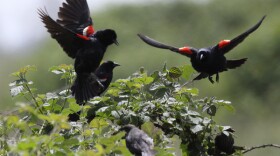Late last year the Tricolored Blackbird became a candidate for the California Endangered Species List. The population of the bird mostly native to the Golden State has plummeted making flocks harder and harder to find. Both bird enthusiasts and farmers are working to keep the colorful bird from extinction.
On Steve Shehadey's dairy near Kerman he has over 7,000 cows. But it’s not just heifers and calves on this 5,000 acre farm. There are almond trees and fields of grain used for cattle feed, plus thousands of blackbirds living among Shehadey's herd.

“You can drive out here anytime and you’ll see colonies of birds picking at insects, looking for food,” Shehadey says. “Over the last several years there’s a lot less dairies, and there’s a lot less ground and with the drought it’s made it tough on the birds.”
Lots of these feathered creatures are Tricolored Blackbirds. They’re about six inches long and look like a normal blackbird, but with a red spot and a white stripe on their shoulders. Shehadey and I meet Samantha Arthur with Audubon California in the middle of one of his grain fields where a colony of over 7,000 birds recently decided to call home.
“We are walking right next to a dense patch of mugwort that tri-colored blackbirds have selected for a colony site,” Arthur says. “And then right over this berm here is a field of triticale where they’re also nesting on the dairy there.”
"We have plenty of feed for our cows, but for a small dairymen that may only have 100 acres and he needs that feed for his cows for a whole year. If he loses a percentage of that it could impact his cows." - Steve Shehadey

The birds are nesting here because there’s just not enough natural habitat left in Central California for them to lay their eggs. That’s great for the birds but also potentially a problem when farmers go to harvest which can crush thousands of eggs and baby birds.
“Last week I saw them carrying nesting material here,” says Arthur. “So the females come back they got the grasses in their beaks and this activity probably picking up insects, feeding.”
The birds fly solo most of the year but come together as a colony for about a month during mating and nesting until the nestlings are ready to fly off. Arthur roams the state looking for colonies of the threatened bird.

“Tricolored Blackbirds have experienced an alarming decline in recent year,” Arthur says. “We’ve seen from statewide surveys a 44% drop from [2011]to 2014.”
At one time there were millions of these birds flying around the state, but Audubon California reports there are as few as 150,000 left. In response to this drop in population the California Fish and Game Commission is considering listing the bird as an endangered species later this year. Arthur blames that decrease on a loss of foraging ground and marshland for nesting.
“Tricolored Blackbirds are the last bird on land in North America that nests in big groups,” Arthur says. “If you were to walk through a colony you could see tens of nests just right around you.”
"Their call kind of sounds like a cat. That's the males saying hey parties on right here." - Tara Wertz
When giant colonies of Tricolored Blackbirds choose to nest in grain fields farmers like Shehadey can apply for a payment from the United States Department of Agriculture Natural Resources Conservation Service. It’s a little over $600 per acre to aid in covering the costs of delaying harvest. Shehadey says the program helps, but for some farmers it’s not enough.
“It does create a hardship for the farmers,” says Shehadey. “We’ve got enough ground where we have plenty of feed for our cows, but for a small dairymen that may only have 100 acres and he needs that feed for his cows for a whole year. If he loses a percentage of that it could impact his cows.”
Before this incentive program began some farmers would harvest their fields knowing they’d kill thousands of baby birds because they need the grain. So far seven farmers are participating in the program covering 400 acres. Officials hope other farmers will use the money to buy grain instead of harvesting when the birds are nesting.
About an hour north of the colony of Tricolored Blackbirds at the dairy, Tara Wertz is studying a group of around 5,000 birds at the Merced National Wildlife Refuge.

“[Their] call kind of sounds like a cat," Wertz says. "That’s the males saying hey parties on right here."
Wertz planted a plot of grain on the 10,000 acre refuge known for waterfowl. She wanted to attract the Tricolored Blackbird.
“So we had this really nice green lush field of oats and barley and all kinds of great stuff the birds liked last year,” Wertz says. “This year they’re not using it at all, but they love this weed patch that’s growing.”
She found when the birds had the option between natural habitat, like milk thistle, or planted fields they chose the natural option. But Wertz points out there isn’t enough natural habitat left in the state to support a larger population of the species. That’s why programs like the one providing funds to dairymen like Shehadey are essential.
“It shows that farmers are environmentalists,” Shehadey says. “We live and take care of our environment every day. There’s wildlife out here 365 days a year. We have water and feed that helps them sustain their species.”
It’s efforts like this that both dairymen and bird watchers hope that the California Fish and Game Commission take into consideration when making a decision on whether to list the black, red and white bird in December.





